• Flags
• historical Flags
• Meaning/Origin of the Flag
• Coat of Arms
• historical Coats of Arms
• Meaning/Origin of the Coat of Arms
• Cockade
• Map
• Numbers and Facts
• History
• The states of Hesse
• Origin of the Country's Name
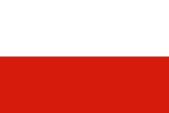
Flag of the country (colours),
Source, by: Wikipedia (D)



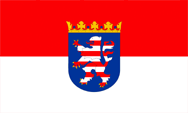
State flag,
Source, by: Wikipedia (D)







Electorate of Hesse(-Kassel),
1813–1866,
Flag of the country (colours),
Source, by: Flags of the World



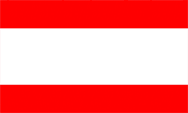
Grand Duchy of Hesse(-Darmstadt),
1839–1918,
Flag of the country (colours),
Source, by: Flags of the World




People's Staate of Hesse,
1923–1933,
Flag of the country (colours),
Source, by: Flags of the World




People's Staate of Hesse,
1933–1934,
Flag of the country (colours),
Source, by: Flags of the World



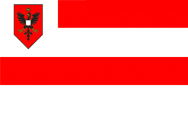
Free City of Frankfurt,
to 1866,
Source, by: Flags of the World



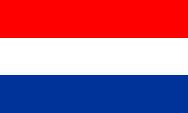
Prussian province of Hesse-Nassau
1868–1934,
Flag of the country (colours),





The today's Hessen consists in the largest parts from territories of the following countries:
• Landgraviate of Hesse-Kassel, since 1803 Electorate of Hesse, since 1866 to the Prussian province of Hesse-Nassau, 1945 to Great Hessen
• Landgraviate of Hesse-Darmstadt, since 1806 Grand Duchy of Hesse, 1923–1945 People's State of Hesse, 1945 to Great Hesse
• Landgraviate of Hesse-Homburg, from 1596, since 1866 to the Prussian Province of Hesse-Nassau
• Duchy of Nassau, since 1866 to the Prussian Province of Hesse-Nassau, 1945 to Great Hessen
• City of Frankfurt, since 1372 Free City, 1810–1813 Grand Duchy, since 1866 to the Prussian Province of Hesse-Nassau, 1945 to Great Hessen
The flags of the Hessian Landgraviates were always red-and white or white-red striped bicolours. The colours go back to the lion in the coat of arms of the Landgraviate of Thuringia in the 12th and 13th centuries, from which the country finally emerged, which was horizontally striped in white and red. In 1806 the Landgraviate of Hesse-Darmstadt became levied to the Grand Guchy of Hesse and in 1839 was introduced a new flag. It was a three striped bicolore, with three stripes in red, white and red in the rato 1:2:1, with the blue shield and the white-red striped lion in the middle. It was in use until 1903. It could be used without coat of arms by anyone until 1933. In 1945 the Prussian Province of Hesse-Nassau, and the Country of Hesse (Hessen-Darmstadt) were combined by the allies, with exception of Rhine Hesse, to "Great Hesse". Coat of arms and flag maintained (although on arms the shape and crown was changed a little bit), and in 1949, when the state of Hesse became a federal country of the FRG, they were taken over.
Source: Reservistenverband Kreisgruppe Südhessen,
Wikipedia (D),
Flags of the World,
Snamjena Germanii


since 1948,
Coat of arms of Hesse,
Source, by:
Wikipedia (D)


1815–1866,
lesser coat of arms of Electorate of Hesse

1808–1918,
lesser coat of arms of Grand Duchy of Hesse,
Source, by: Heraldique Europeenne
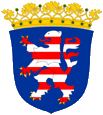
1923–1934,
Coat of arms of People's State of Hesse,
Source, by: Wikipedia (D)
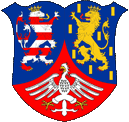
1866–1934,
Coat of arms of the Prussian Province of Hesse-Nassau,
Source, by: Wikipedia (D)

The coats of arms of the Hessian Landgraviates showed a blue shield with a white and red striped lion. This golden armed, golden crowned, lion rampante is the Lion of the Ludowingers, an originally Thuringian symbol, which goes back to the end of the 12th century, to the Landgrave Hermann I. of the dynasty of the Ludowingers.
Originally, the lion was depicted with eight white and red striped bars, in the 15th Century, there arised nine stripes. There exist depictions of the lion with one or two tails. This is without heraldic significance.
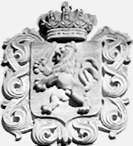
Source:
Historischer Verein Ingelheim
After the extinction of the male line of Landgraves – the House of Ludowinger – in 1247, there was a succession war between the Margraves of Meissen (House Wettin) and the Duchy of Brabant (Sophie, Duchess of Brabant, House of Ludowinger). The war ended in 1264 and much parts in the east of the Landgraviate of Thuringia came to the House of Wettin. Those became later the Wettin-Ernestine duchies. The West came as Landgraviate of Hesse to the son of Sophie of Brabant. The Thuringian coat of arms (white-red striped lion on blue) was adopted by both dynasties. The as a result of the Hessian division of 1567 (and even later) arising lines of the Landgraves of Hesse, all continued the blue shield with the white-red striped with lion. Only the lion in the coat of arms of Hesse-Darmstadt became in 1808 pushed a drawn sword in the paw. It stands for the in the same year awarded title of the Grand Duke of Hesse: "Champion between Rhine and Weser rivers". After revolution and overthrow of the monarchy in the year 1918, was removed the crown on the shield and on the head of the lion in 1923, it became taken off the sword, and it was determined that the lion should consistently have one single tail, the shape of the shield was changed and a "people's crown" was placed on the shield.
In 1945 the Prussian Province of Hesse-Nassau, and the Country of Hesse (Hessen-Darmstadt) were combined by the allies, with exception of Rhine Hesse, to "Great Hesse". Coat of arms and flag maintained (although on arms the shape and crown was changed a little bit), and in 1949, when the state of Hesse became a federal country of the FRG, they were taken over.
Source: Wikipedia (D),
Flags of the World


to 1919,
Cockade of the Grand Duchy of Hesse-Darmstadt

Read here:
Informations, history and facts about the theme "Cockades".

Cockade

FRG and its countries, clickable map:
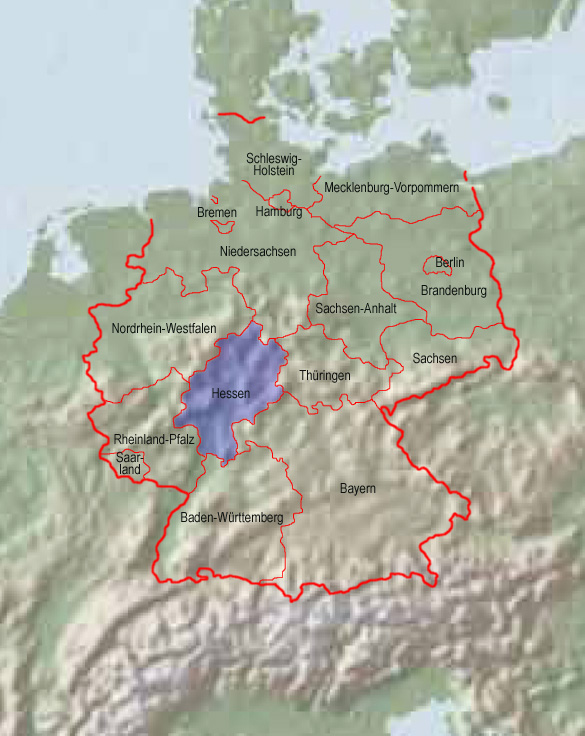
Source: Freeware, University of Texas Libraries, modyfied by: Volker Preuß

Area: 8.152 square miles
Inhabitants: 6.087.000 (2011)
Density of Population: 747 inh./sq.mi. (2011)
Religions: 40% Protestant, 25% Roman Catholic
Capital: Wiesbaden, 276.000 inh.
official Language: German
Currency in Hessen-Kassel to 1866: 1 Taler = 30 Groschen = 360 Pfennige, from 1866 Prussian Currency
Currency in Frankfurt and Nassau to 1866: 1 Gulden = 60 Kreuzer = 240 Pfennige, from 1866 Prussian Currency
Currency in Hesse-Darmstadt to 1871: 1 Gulden = 60 Kreuzer = 240 Pfennige
Currency in Hesse-Darmstadt 1871–1924: 1 Mark = 100 Pfennige
Currency in People's State of Hesse 1924–1948: 1 Reichsmark (RM) = 100 Reichspfennige (Rpf.)
Source: Der Michel,
Wikipedia (D)

1145–1254 · Landgraviate of Thuringia
1254–1264 · heritage succession war, separation of Hesse from Thuringia
1264 · Landgraviate of Hesse
1567 · division of the ruling family in four different lines (1. Landgraviate of Hesse-Kassel [since 1803 Electorate of Hesse, since 1866 to the Prussian Province of Hesse-Nassau], 2. Landgraviate of Hesse-Darmstadt [1806–1918 Grand Duchy of Hesse, 1918–1945 People's State of Hesse], 3. Landgraviate of Hesse-Marburg [to 1604], 4. Landgraviate of Hesse-Rheinfels [to 1583])
1596 · formation of the Landgraviate of Hesse-Homburg [since 1866 to the Prussian Province of Hesse-Nassau], to 1866 under the suzerainty of Hesse-Darmstadt
1866 · Fratricidal War of Prussia against Austria, Hessen-Homburg and Hessen-Kassel expire
1918 · revolution in Hessen-Darmstadt, fall of the monarchy
1923 · declaraion of the "People's State of Hesse"
1918–1945 · country of the German Empire
1945 · Hesse is occupied by US-American troops
1945 · establish of Greater Hessen by merge of Hesse-Darmstadt with Hesse-Nassau under loss of Rhine Hesse
1946 · Country of Hesse
1949 · the Country of Hesse becomes a federal country of the FRG
Source: Atlas zur Geschichte,
World Statesmen,
HGIS - Historisches Deutschland

1.) from 1567 Landgraviate of Hesse-Kassel, since 1803 Electorate of Hesse, since 1866 to the Prussian Province of Hesse-Nassau
2.) from 1567 Landgraviate of Hesse-Darmstadt, 1803–1918 Grand Duchy of Hesse, 1918–1945 Federal Country of Hesse
3.) from 1596 Landgraviate of Hesse-Homburg, since 1866 to the Prussian
Province of Hesse-Nassau
4.) 1567–1604 Landgraviate of Hesse-Marburg
5.) 1567–1583 Landgraviate of Hesse-Rheinfels
6.) 1648–1681 Landgraviate of Hesse-Bingenheim
Source, by: Wikipedia (D)

The name "Hesse" is based on a Germanic tribe with the same name who lived here during the time of the Romans. This tribes was called by the Romans "Chatti".
Source: Handbuch der geographischen Namen







![]()



































![]()